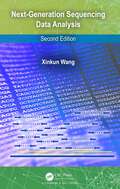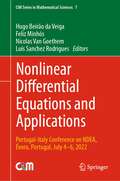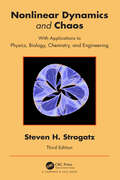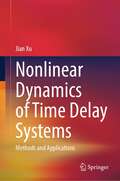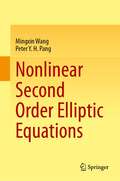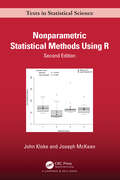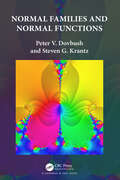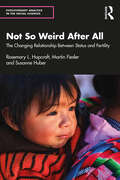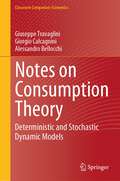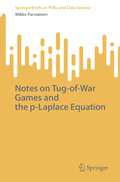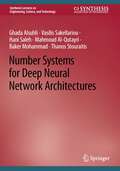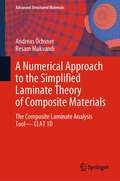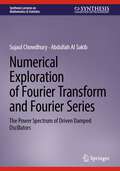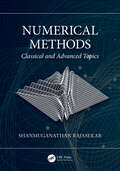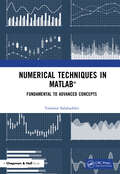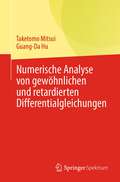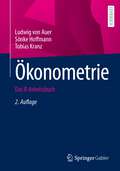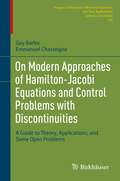- Table View
- List View
Next-Generation Sequencing Data Analysis
by Xinkun WangRNA-seq: both bulk and single-cell (separate chapters) Genotyping and variant discovery through whole genome/exome sequencing Clinical sequencing and detection of actionable variants De novo genome assembly ChIP-seq to map protein-DNA interactions Epigenomics through DNA methylation sequencing Metagenome sequencing for microbiome analysis
Next-Generation Sequencing Data Analysis
by Xinkun WangRNA-seq: both bulk and single-cell (separate chapters) Genotyping and variant discovery through whole genome/exome sequencing Clinical sequencing and detection of actionable variants De novo genome assembly ChIP-seq to map protein-DNA interactions Epigenomics through DNA methylation sequencing Metagenome sequencing for microbiome analysis
Nonlinear Differential Equations and Applications: Portugal-Italy Conference on NDEA, Évora, Portugal, July 4–6, 2022 (CIM Series in Mathematical Sciences #7)
by Hugo Beirão da Veiga Feliz Minhós Nicolas Van Goethem Luís Sanchez RodriguesThis proceedings volume gathers selected, carefully reviewed works presented at the Portugal-Italy Conference on Nonlinear Differential Equations and Applications (PICNDEA22), held on July 4-6, 2022, at the University of Évora, Portugal.The main focus of this work lies in non-linear problems originating in applications and their treatment with numerical analysis. The reader will also find new advances on topics such as ordinary and partial differential equations, numerical analysis, topological and variational methods, fluid mechanics, operator theory, stability, and more.The Portugal-Italy Conference on Nonlinear Differential Equations and Applications convenes Italian and Portuguese researchers in differential equations and their applications to amplify previous collaboration and to follow and discuss new topics in the area. Reflecting the increasing teamwork involving the two mathematical communities, the conference has been opened to researchers from all nationalities.While researchers in analysis and related fields are the primary readership of this volume, PhD students can rely on this book as a valuable source to keep pace with recent advances in differential equations and cutting-edge applications.
Nonlinear Dynamics and Chaos: With Applications to Physics, Biology, Chemistry, and Engineering
by Steven H StrogatzThe goal of this third edition of Nonlinear Dynamics and Chaos: With Applications to Physics, Biology, Chemistry, and Engineering is the same as previous editions: to provide a good foundation - and a joyful experience - for anyone who’d like to learn about nonlinear dynamics and chaos from an applied perspective.The presentation stresses analytical methods, concrete examples, and geometric intuition. The theory is developed systematically, starting with first-order differential equations and their bifurcations, followed by phase plane analysis, limit cycles and their bifurcations, and culminating with the Lorenz equations, chaos, iterated maps, period doubling, renormalization, fractals, and strange attractors.The prerequisites are comfort with multivariable calculus and linear algebra, as well as a first course in physics. Ideas from probability, complex analysis, and Fourier analysis are invoked, but they're either worked out from scratch or can be safely skipped (or accepted on faith).Changes to this edition include substantial exercises about conceptual models of climate change, an updated treatment of the SIR model of epidemics, and amendments (based on recent research) about the Selkov model of oscillatory glycolysis. Equations, diagrams, and every word has been reconsidered and often revised. There are also about 50 new references, many of them from the recent literature.The most notable change is a new chapter. Chapter 13 is about the Kuramoto model.The Kuramoto model is an icon of nonlinear dynamics. Introduced in 1975 by the Japanese physicist Yoshiki Kuramoto, his elegant model is one of the rare examples of a high-dimensional nonlinear system that can be solved by elementary means.Students and teachers have embraced the book in the past, its general approach and framework continue to be sound.
Nonlinear Dynamics and Chaos: With Applications to Physics, Biology, Chemistry, and Engineering
by Steven H StrogatzThe goal of this third edition of Nonlinear Dynamics and Chaos: With Applications to Physics, Biology, Chemistry, and Engineering is the same as previous editions: to provide a good foundation - and a joyful experience - for anyone who’d like to learn about nonlinear dynamics and chaos from an applied perspective.The presentation stresses analytical methods, concrete examples, and geometric intuition. The theory is developed systematically, starting with first-order differential equations and their bifurcations, followed by phase plane analysis, limit cycles and their bifurcations, and culminating with the Lorenz equations, chaos, iterated maps, period doubling, renormalization, fractals, and strange attractors.The prerequisites are comfort with multivariable calculus and linear algebra, as well as a first course in physics. Ideas from probability, complex analysis, and Fourier analysis are invoked, but they're either worked out from scratch or can be safely skipped (or accepted on faith).Changes to this edition include substantial exercises about conceptual models of climate change, an updated treatment of the SIR model of epidemics, and amendments (based on recent research) about the Selkov model of oscillatory glycolysis. Equations, diagrams, and every word has been reconsidered and often revised. There are also about 50 new references, many of them from the recent literature.The most notable change is a new chapter. Chapter 13 is about the Kuramoto model.The Kuramoto model is an icon of nonlinear dynamics. Introduced in 1975 by the Japanese physicist Yoshiki Kuramoto, his elegant model is one of the rare examples of a high-dimensional nonlinear system that can be solved by elementary means.Students and teachers have embraced the book in the past, its general approach and framework continue to be sound.
Nonlinear Dynamics of Time Delay Systems: Methods and Applications
by Jian XuThis book presents research advancements in the dynamics of systems with time delay conducted by the group led by Professor Jian Xu. Addressing the challenges arising from the joint impact of time delay and nonlinearity, novel theoretical approaches are developed to formulate the nonlinear response of the system. This facilitates the classification of complex nonlinear dynamics, especially the non-resonant and resonant double Hopf bifurcation. In contrast to systems without time delay, time delay systems require specific considerations when identifying system parameters, particularly the time delay. Consequently, inverse problems of systems with time delay are also explored in this book. Moreover, detailed investigations on vibration suppression methods and experimental prototypes based on time delay, such as time delay isolators with quasi-zero stiffness, are conducted. Simultaneously, this book is enriched with a large number of case studies ranging from manufacturing, network science, biology, and public transportation, illuminating the mechanisms of delay-induced nonlinear dynamics in practical applications. This book is suitable for graduate students and researchers who are eager to understand the delay-induced nonlinear dynamics, or technical personnel in whose projects small variations of time delay may cause significant changes in system responses.
Nonlinear Second Order Elliptic Equations
by Mingxin Wang Peter Y. PangThis book focuses on the following three topics in the theory of boundary value problems of nonlinear second order elliptic partial differential equations and systems: (i) eigenvalue problem, (ii) upper and lower solutions method, (iii) topological degree method, and deals with the existence of solutions, more specifically non-constant positive solutions, as well as the uniqueness, stability and asymptotic behavior of such solutions.While not all-encompassing, these topics represent major approaches to the theory of partial differential equations and systems, and should be of significant interest to graduate students and researchers. Two appendices have been included to provide a good gauge of the prerequisites for this book and make it reasonably self-contained.A notable strength of the book is that it contains a large number of substantial examples. Exercises for the reader are also included. Therefore, this book is suitable as a textbook for graduate students who havealready had an introductory course on PDE and some familiarity with functional analysis and nonlinear functional analysis, and as a reference for researchers.
Nonparametric Statistical Methods Using R (Chapman & Hall/CRC Texts in Statistical Science)
by John Kloke Joseph McKeanPraise for the first edition:“This book would be especially good for the shelf of anyone who already knows nonparametrics, but wants a reference for how to apply those techniques in R.”-The American StatisticianThis thoroughly updated and expanded second edition of Nonparametric Statistical Methods Using R covers traditional nonparametric methods and rank-based analyses. Two new chapters covering multivariate analyses and big data have been added. Core classical nonparametrics chapters on one- and two-sample problems have been expanded to include discussions on ties as well as power and sample size determination. Common machine learning topics --- including k-nearest neighbors and trees --- have also been included in this new edition.Key Features: Covers a wide range of models including location, linear regression, ANOVA-type, mixed models for cluster correlated data, nonlinear, and GEE-type. Includes robust methods for linear model analyses, big data, time-to-event analyses, timeseries, and multivariate. Numerous examples illustrate the methods and their computation. R packages are available for computation and datasets. Contains two completely new chapters on big data and multivariate analysis. The book is suitable for advanced undergraduate and graduate students in statistics and data science, and students of other majors with a solid background in statistical methods including regression and ANOVA. It will also be of use to researchers working with nonparametric and rank-based methods in practice.
Nonparametric Statistical Methods Using R (Chapman & Hall/CRC Texts in Statistical Science)
by John Kloke Joseph McKeanPraise for the first edition:“This book would be especially good for the shelf of anyone who already knows nonparametrics, but wants a reference for how to apply those techniques in R.”-The American StatisticianThis thoroughly updated and expanded second edition of Nonparametric Statistical Methods Using R covers traditional nonparametric methods and rank-based analyses. Two new chapters covering multivariate analyses and big data have been added. Core classical nonparametrics chapters on one- and two-sample problems have been expanded to include discussions on ties as well as power and sample size determination. Common machine learning topics --- including k-nearest neighbors and trees --- have also been included in this new edition.Key Features: Covers a wide range of models including location, linear regression, ANOVA-type, mixed models for cluster correlated data, nonlinear, and GEE-type. Includes robust methods for linear model analyses, big data, time-to-event analyses, timeseries, and multivariate. Numerous examples illustrate the methods and their computation. R packages are available for computation and datasets. Contains two completely new chapters on big data and multivariate analysis. The book is suitable for advanced undergraduate and graduate students in statistics and data science, and students of other majors with a solid background in statistical methods including regression and ANOVA. It will also be of use to researchers working with nonparametric and rank-based methods in practice.
Normal Families and Normal Functions
by Peter V. Dovbush Steven G. KrantzThis book centers on normal families of holomorphic and meromorphic functions and also normal functions. The authors treat one complex variable, several complex variables, and infinitely many complex variables (i.e., Hilbert space).The theory of normal families is more than 100 years old. It has played a seminal role in the function theory of complex variables. It was used in the first rigorous proof of the Riemann mapping theorem. It is used to study automorphism groups of domains, geometric analysis, and partial differential equations.The theory of normal families led to the idea, in 1957, of normal functions as developed by Lehto and Virtanen. This is the natural class of functions for treating the Lindelof principle. The latter is a key idea in the boundary behavior of holomorphic functions.This book treats normal families, normal functions, the Lindelof principle, and other related ideas. Both the analytic and the geometric approaches to the subject area are offered. The authors include many incisive examples.The book could be used as the text for a graduate research seminar. It would also be useful reading for established researchers and for budding complex analysts.
Normal Families and Normal Functions
by Peter V. Dovbush Steven G. KrantzThis book centers on normal families of holomorphic and meromorphic functions and also normal functions. The authors treat one complex variable, several complex variables, and infinitely many complex variables (i.e., Hilbert space).The theory of normal families is more than 100 years old. It has played a seminal role in the function theory of complex variables. It was used in the first rigorous proof of the Riemann mapping theorem. It is used to study automorphism groups of domains, geometric analysis, and partial differential equations.The theory of normal families led to the idea, in 1957, of normal functions as developed by Lehto and Virtanen. This is the natural class of functions for treating the Lindelof principle. The latter is a key idea in the boundary behavior of holomorphic functions.This book treats normal families, normal functions, the Lindelof principle, and other related ideas. Both the analytic and the geometric approaches to the subject area are offered. The authors include many incisive examples.The book could be used as the text for a graduate research seminar. It would also be useful reading for established researchers and for budding complex analysts.
Not So Weird After All: The Changing Relationship Between Status and Fertility (Evolutionary Analysis in the Social Sciences)
by Rosemary L. Hopcroft Martin Fieder Susanne HuberThis is the first book to fully examine, from an evolutionary point of view, the association of social status and fertility in human societies before, during, and after the demographic transition. In most nonhuman social species, social status or relative rank in a social group is positively associated with the number of offspring, with high-status individuals typically having more offspring than low-status individuals. However, humans appear to be different. As societies have gotten richer, fertility has dipped to unprecedented lows, with some developed societies now at or below replacement fertility. Within rich societies, women in higher-income families often have fewer children than women in lower-income families. Evolutionary theory suggests that the relationship between social status and fertility is likely to be somewhat different for men and women, so it is important to examine this relationship for men and women separately. When this is done, the positive association between individual social status and fertility is often clear in less-developed, pre-transitional societies, particularly for men. Once the demographic transition begins, it is elite families, particularly the women of elite families, who lead the way in fertility decline. Post-transition, the evidence from a variety of developed societies in Europe, North America and East Asia is that high-status men (particularly men with high personal income) do have more children on average than lower-status men. The reverse is often true of women, although there is evidence that this is changing in Nordic countries. The implications of these observations for evolutionary theory are also discussed. This book will be of interest to students and researchers in the social sciences with an interest in evolutionary sociology, evolutionary anthropology, evolutionary psychology, demography, and fertility.
Not So Weird After All: The Changing Relationship Between Status and Fertility (Evolutionary Analysis in the Social Sciences)
by Rosemary L. Hopcroft Martin Fieder Susanne HuberThis is the first book to fully examine, from an evolutionary point of view, the association of social status and fertility in human societies before, during, and after the demographic transition. In most nonhuman social species, social status or relative rank in a social group is positively associated with the number of offspring, with high-status individuals typically having more offspring than low-status individuals. However, humans appear to be different. As societies have gotten richer, fertility has dipped to unprecedented lows, with some developed societies now at or below replacement fertility. Within rich societies, women in higher-income families often have fewer children than women in lower-income families. Evolutionary theory suggests that the relationship between social status and fertility is likely to be somewhat different for men and women, so it is important to examine this relationship for men and women separately. When this is done, the positive association between individual social status and fertility is often clear in less-developed, pre-transitional societies, particularly for men. Once the demographic transition begins, it is elite families, particularly the women of elite families, who lead the way in fertility decline. Post-transition, the evidence from a variety of developed societies in Europe, North America and East Asia is that high-status men (particularly men with high personal income) do have more children on average than lower-status men. The reverse is often true of women, although there is evidence that this is changing in Nordic countries. The implications of these observations for evolutionary theory are also discussed. This book will be of interest to students and researchers in the social sciences with an interest in evolutionary sociology, evolutionary anthropology, evolutionary psychology, demography, and fertility.
Notes on Consumption Theory: Deterministic and Stochastic Dynamic Models (Classroom Companion: Economics)
by Giuseppe Travaglini Giorgio Calcagnini Alessandro BellocchiThis textbook offers a compact, yet formal, synthesis of the broad field of consumption theory. Written in a coherent and accessible way, this book introduces graduate and postgraduate students to dynamic optimization applied to consumption under certainty and uncertainty, in discrete and continuous time. Delving into deterministic and stochastic models, including the use of Brownian motions, the book offers a deeper understanding of consumption decisions and their impact on asset pricing and investment in partial and general equilibrium. This book compiles lecture notes from advanced courses in micro- and macroeconomics, ensuring a self-contained introduction to the subject. Balancing simplicity with analytical rigor, the book equips readers with essential methodological tools for advanced research in economics. With empirical evidence and exercises integrated throughout, this textbook stands as the go-to resource for scholars and students alike, fostering further theoretical explorations in the field. Basic knowledge of economics, mathematics, and econometrics is recommended for a comprehensive understanding.
Notes on Tug-of-War Games and the p-Laplace Equation (SpringerBriefs on PDEs and Data Science)
by Mikko ParviainenThis book addresses the interplay between stochastic processes and partial differential equations. More specifically, it focuses on the connection between the nonlinear p-Laplace equation and the stochastic game called tug-of-war with noise. The connection in this context was discovered approximately 15 years ago and has since provided new insights and approaches. These lecture notes provide a brief but detailed and accessible introduction to the subject and to the more research-oriented literature. The book also presents the parabolic case side by side with the elliptic case, highlighting the fact that elliptic and parabolic equations are close in spirit in certain aspects. Moreover, it covers some parts of the regularity theory for these problems. Graduate students and advanced undergraduate students with a basic understanding of probability and partial differential equations will find this book useful.
Number Systems for Deep Neural Network Architectures (Synthesis Lectures on Engineering, Science, and Technology)
by Ghada Alsuhli Vasilis Sakellariou Hani Saleh Mahmoud Al-Qutayri Baker Mohammad Thanos StouraitisThis book provides readers a comprehensive introduction to alternative number systems for more efficient representations of Deep Neural Network (DNN) data. Various number systems (conventional/unconventional) exploited for DNNs are discussed, including Floating Point (FP), Fixed Point (FXP), Logarithmic Number System (LNS), Residue Number System (RNS), Block Floating Point Number System (BFP), Dynamic Fixed-Point Number System (DFXP) and Posit Number System (PNS). The authors explore the impact of these number systems on the performance and hardware design of DNNs, highlighting the challenges associated with each number system and various solutions that are proposed for addressing them.
A Numerical Approach to the Simplified Laminate Theory of Composite Materials: The Composite Laminate Analysis Tool—CLAT 1D (Advanced Structured Materials #202)
by Andreas Öchsner Resam MakvandiA typical approach to treat composite materials, which are composed of layered unidirectional lamina, is the so-called classical laminate theory (CLT). This theory is based on the theory for plane elasticity elements and classical (shear-rigid) plate elements under the assumption of orthotropic constitutive equations. The solution of the fundamental equations of the classical laminate theory is connected with extensive matrix operations and many problems require in addition iteration loops.This two-dimensional approach and the underlying advanced continuum mechanical modeling might be very challenging for some students, particularly at universities of applied sciences. Thus, a reduced approach, the so-called simplified classical laminate theory (SCLT), has been recently proposed. The idea was to use solely isotropic one-dimensional elements, i.e., a superposition of bar and beam elements, to introduce the major calculation steps of the classical laminate theory. Understandingthis simplified theory is much easier and the final step it to highlight the differences when moving to the general two-dimensional case.This monograph first provides a systematic and thorough introduction to the simplified laminate theory based on the theory for bars and classical beam plate elements. The focus is on stacking of isotropic layers to simplified laminates. In addition to the elastic behavior, failure is investigated based on the maximum stress, maximum strain, Tsai-Hill, and the Tsai-Wu criteria. We provide a Python-based computational tool, the so-called Composite Laminate Analysis Tool (CLAT 1D) to easily solve some standard questions from the context of fiber reinforced composites. The tool runs in any standard web browser and offers a user-friendly interface with many post-processing options. The functionality comprises stress and strain analysis of simplified lamina and laminates and the failure analysis based on different criteria.
Numerical Exploration of Fourier Transform and Fourier Series: The Power Spectrum of Driven Damped Oscillators (Synthesis Lectures on Mathematics & Statistics)
by Sujaul Chowdhury Abdullah Al SakibThis book presents practical demonstrations of numerically calculating or obtaining Fourier Transform. In particular, the authors demonstrate how to obtain frequencies that are present in numerical data and utilizes Mathematica to illustrate the calculations. This book also contains numerical solution of differential equation of driven damped oscillator using 4th order Runge-Kutta method. Numerical solutions are compared with analytical solutions, and the behaviors of mechanical system are also depicted by plotting velocity versus displacement rather than displaying displacement as a function of time. This book is useful to physical science and engineering professionals who often need to obtain frequencies present in numerical data using the discrete Fourier transform.This book: Aids readers to numerically calculate or obtain frequencies that are present in numerical dataExplores the use of the discrete Fourier transform and demonstrates practical numerical calculationUtilizes 4th order Runge-Kutta method and Mathematica for the numerical solution of differential equation
Numerical Methods: Classical and Advanced Topics
by Shanmuganathan RajasekarThis book presents a pedagogical treatment of a wide range of numerical methods to suit the needs of undergraduate and postgraduate students, and teachers and researchers in physics, mathematics, and engineering. For each method, the derivation of the formula/algorithm, error analysis, case studies, applications in science and engineering and the special features are covered. A detailed presentation of solving time-dependent Schrödinger equation and nonlinear wave equations, along with the Monte Carlo techniques (to mention a few) will aid in students’ understanding of several physical phenomena including tunnelling, elastic collision of nonlinear waves, electronic distribution in atoms, and diffusion of neutrons through simulation study.The book covers advanced topics such as symplectic integrators and random number generators for desired distributions and Monte Carlo techniques, which are usually overlooked in other numerical methods textbooks. Interesting updates on classical topics include: curve fitting to a sigmoid and Gaussian functions and product of certain two functions, solving of differential equations in the presence of noise, and solving the time-independent Schrödinger equation.Solutions are presented in the forms of tables and graphs to provide visual aid and encourage a deeper comprehension of the topic. The step-by-step computations presented for most of the problems can be verifiable using a scientific calculator and is therefore appropriate for classroom teaching. The readers of the book will benefit from acquiring an acquittance, knowledge, experience and realization of significance of the numerical methods covered, their applicability to physical and engineering problems and the advantages of applying numerical methods over theoretical methods for specific problems.
Numerical Methods: Classical and Advanced Topics
by Shanmuganathan RajasekarThis book presents a pedagogical treatment of a wide range of numerical methods to suit the needs of undergraduate and postgraduate students, and teachers and researchers in physics, mathematics, and engineering. For each method, the derivation of the formula/algorithm, error analysis, case studies, applications in science and engineering and the special features are covered. A detailed presentation of solving time-dependent Schrödinger equation and nonlinear wave equations, along with the Monte Carlo techniques (to mention a few) will aid in students’ understanding of several physical phenomena including tunnelling, elastic collision of nonlinear waves, electronic distribution in atoms, and diffusion of neutrons through simulation study.The book covers advanced topics such as symplectic integrators and random number generators for desired distributions and Monte Carlo techniques, which are usually overlooked in other numerical methods textbooks. Interesting updates on classical topics include: curve fitting to a sigmoid and Gaussian functions and product of certain two functions, solving of differential equations in the presence of noise, and solving the time-independent Schrödinger equation.Solutions are presented in the forms of tables and graphs to provide visual aid and encourage a deeper comprehension of the topic. The step-by-step computations presented for most of the problems can be verifiable using a scientific calculator and is therefore appropriate for classroom teaching. The readers of the book will benefit from acquiring an acquittance, knowledge, experience and realization of significance of the numerical methods covered, their applicability to physical and engineering problems and the advantages of applying numerical methods over theoretical methods for specific problems.
Numerical Techniques in MATLAB: Fundamental to Advanced Concepts
by Taimoor SalahuddinIn this book, various numerical methods are discussed in a comprehensive way. It delivers a mixture of theory, examples and MATLAB® practicing exercises to help the students in improving their skills. To understand the MATLAB programming in a friendly style, the examples are solved. The MATLAB codes are mentioned in the end of each topic. Throughout the text, a balance between theory, examples and programming is maintained. Key Features Methods are explained with examples and codes System of equations has given full consideration Use of MATLAB is learnt for every method This book is suitable for graduate students in mathematics, computer science and engineering.
Numerical Techniques in MATLAB: Fundamental to Advanced Concepts
by Taimoor SalahuddinIn this book, various numerical methods are discussed in a comprehensive way. It delivers a mixture of theory, examples and MATLAB® practicing exercises to help the students in improving their skills. To understand the MATLAB programming in a friendly style, the examples are solved. The MATLAB codes are mentioned in the end of each topic. Throughout the text, a balance between theory, examples and programming is maintained. Key Features Methods are explained with examples and codes System of equations has given full consideration Use of MATLAB is learnt for every method This book is suitable for graduate students in mathematics, computer science and engineering.
Numerische Analyse von gewöhnlichen und retardierten Differentialgleichungen
by Taketomo Mitsui Guang-Da HuDieses Buch dient als prägnantes Lehrbuch für Studenten in einem fortgeschrittenen Undergraduate- oder First-Year-Graduate-Kurs in verschiedenen Disziplinen wie angewandte Mathematik, Steuerung und Ingenieurwesen, die den modernen Standard der numerischen Methoden von gewöhnlichen und verzögerten Differentialgleichungen verstehen wollen. Experten in denselben Bereichen können sich auch über die jüngsten Entwicklungen in der numerischen Analyse solcher Differentialsysteme informieren. Gewöhnliche Differentialgleichungen (ODEs) sind ein starkes mathematisches Werkzeug, um eine Vielzahl von Phänomenen in Wissenschaft und Technik auszudrücken. Neben ihrer eigenen Bedeutung ist eine der mächtigen Richtungen, in die sich ODEs ausdehnen, die Einbeziehung einer unbekannten Funktion mit verzögertem Argument. Dies wird als verzögerte Differentialgleichungen (Delay differential equations, DDEs) bezeichnet, die häufig in der mathematischen Modellierung vonBiologie, Demographie, Epidemiologie und Kontrolltheorie vorkommen. In einigen Fällen kann die Lösung einer Differentialgleichung durch algebraische Kombinationen bekannter mathematischer Funktionen erhalten werden. In vielen praktischen Fällen ist eine solche Lösung jedoch recht schwierig oder nicht verfügbar, und es sind numerische Näherungen erforderlich. Die moderne Entwicklung von Computern beschleunigt die Situation und eröffnet darüber hinaus mehr Möglichkeiten der numerischen Mittel. Die Kenntnis und das Fachwissen über die numerische Lösung von Differentialgleichungen wird nun in weiten Bereichen der Wissenschaft und des Ingenieurwesens vorausgesetzt.Man könnte meinen, dass ein gut organisiertes Softwarepaket wie MATLAB in etwa die gleiche Lösung bietet. In gewisser Weise stimmt das auch, aber man muss bedenken, dass der blinde Einsatz von Softwarepaketen den Benutzer in die Irre führt. Das Wesentliche der numerischen Lösung von Differentialgleichungen muss noch gelernt werden. Das vorliegende Buch soll das Wesentliche der numerischen Lösungen von gewöhnlichen Differentialgleichungen sowie von Verzögerungsdifferentialgleichungen vermitteln. Die Autoren haben insbesondere festgestellt, dass es noch wenige prägnante Lehrbücher über Verzögerungsdifferentialgleichungen gibt, und haben sich dann daran gemacht, die Lücke durch möglichst transparente Beschreibungen zu schließen. Die wichtigsten Algorithmen zur numerischen Lösung sind in diesem Buch klar beschrieben. Auch die Stabilität von Lösungen von ODEs und DDEs ist von entscheidender Bedeutung. Das Buch führt in die asymptotische Stabilität von analytischen und numerischen Lösungen ein und bietet einen praktischen Weg zur Analyse ihrer Stabilität unter Verwendung einer Theorie komplexer Funktionen.
Ökonometrie: Das R-Arbeitsbuch
by Ludwig von Auer Sönke Hoffmann Tobias KranzDieses R-Arbeitsbuch bietet seinen Leserinnen und Lesern ökonometrische Übungsaufgaben, die eigenständig am Computer bearbeitet werden können. Die notwendigen Kenntnisse des kostenlosen Programmpakets R werden in „R-Boxen“ quasi nebenbei Schritt für Schritt vermittelt. Den Auftakt bildet dabei eine einfache Installationsanleitung. Auch alle Lösungen der Übungsaufgaben sind sorgfältig dokumentiert.Das R-Arbeitsbuch lässt sich zwar mit jedem einführenden Ökonometrie-Lehrbuch kombinieren, die optimale Verzahnung besteht jedoch mit dem Lehrbuch Ökonometrie - Eine Einführung (von Auer, 8. Auflage, 2023). Die Zielgruppe dieser Lehrbuch-Arbeitsbuch-Kombination besitzt weder statistische oder ökonometrische Kenntnisse noch Erfahrung in der Anwendung statistischer Programme. Für die 2. Auflage wurde das R-Arbeitsbuch gründlich überarbeitet und um zusätzliche Aufgaben ergänzt.
On Modern Approaches of Hamilton-Jacobi Equations and Control Problems with Discontinuities: A Guide to Theory, Applications, and Some Open Problems (Progress in Nonlinear Differential Equations and Their Applications #104)
by Guy Barles Emmanuel ChasseigneThis monograph presents the most recent developments in the study of Hamilton-Jacobi Equations and control problems with discontinuities, mainly from the viewpoint of partial differential equations. Two main cases are investigated in detail: the case of codimension 1 discontinuities and the stratified case in which the discontinuities can be of any codimensions. In both, connections with deterministic control problems are carefully studied, and numerous examples and applications are illustrated throughout the text.After an initial section that provides a “toolbox” containing key results which will be used throughout the text, Parts II and III completely describe several recently introduced approaches to treat problems involving either codimension 1 discontinuities or networks. The remaining sections are concerned with stratified problems either in the whole space R^N or in bounded or unbounded domains with state-constraints. In particular, the use of stratified solutions to treat problems with boundary conditions, where both the boundary may be non-smooth and the data may present discontinuities, is developed. Many applications to concrete problems are explored throughout the text – such as Kolmogorov-Petrovsky-Piskunov (KPP) type problems, large deviations, level-sets approach, large time behavior, and homogenization – and several key open problems are presented.This monograph will be of interest to graduate students and researchers working in deterministic control problems and Hamilton-Jacobi Equations, network problems, or scalar conservation laws.
